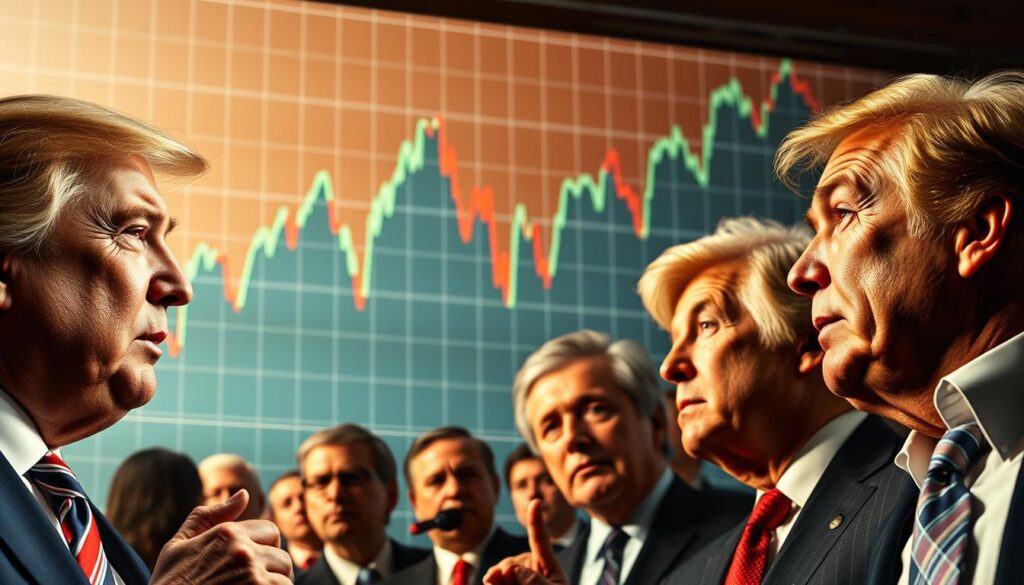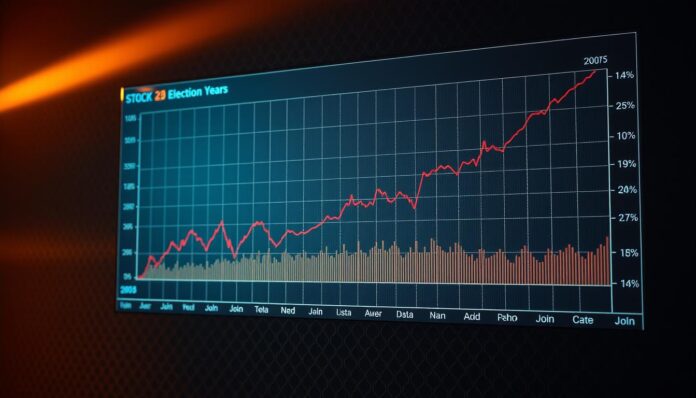Every four years, investors wonder: Do Election Years Affect The Stock Market? As election season approaches, questions about election year stock market correlation rise. Many ask how political changes might disrupt portfolios or create opportunities. This article addresses these concerns, balancing facts with broader market realities.
History shows election year investing trends vary. Some cycles see gains, others dips—but markets rarely move on politics alone. Events like wars, recessions, or tech breakthroughs often matter more. This analysis explores how much weight to give election cycles versus economic fundamentals.
Key Takeaways
- Political cycles alone rarely dictate long-term market behavior.
- Election year stock market correlation exists but is not always direct.
- Investors often overestimate election impact due to media focus.
- Economic data like unemployment and inflation outweigh political noise.
- Staying informed about election year investing trends helps avoid knee-jerk moves.
Understanding the Relationship Between Elections and Stock Markets
Investors often ask how elections influence market trends. The political impact on stock market dynamics has been studied for decades. Analysts track election cycle stock market performance to identify patterns shaping investment strategies.
Historical Context of Election Cycles
Early research in the mid-20th century revealed recurring trends. The presidential election cycle theory suggests markets often rise before elections and stabilize afterward. For example, data since the 1930s shows peaks and dips linked to policy shifts and voter sentiment. These insights form the basis for modern analysis of election cycle stock market performance.
Overview of Economic Indicators
Key economic metrics tied to political cycles include:
| Indicator | Description | Impact on Markets |
|---|---|---|
| GDP Growth | Total economic output | Rising signals stability, boosting investor confidence |
| Unemployment Rate | Measures job availability | Low rates often mean higher consumer spending and stock gains |
| Inflation Rate | Measures price changes | Moderate inflation reflects economic health; high rates can trigger volatility |
These metrics help explain how policy decisions and election outcomes shape market behavior. Understanding their role clarifies the political impact on stock market fluctuations.
Analyzing Market Trends During Election Years
Market behavior during election years often sparks debate among investors. Data reveals distinct patterns, though trends rarely guarantee outcomes. Let’s explore how the stock market during election year has historically moved compared to other periods.
Patterns Observed in Past Elections
- Average S&P 500 returns in election years since 1950 show gains of ~14%, per Federal Reserve data.
- Volatility spikes near election dates, with the VIX index rising 20-30% in months before voting days.
- Defensive sectors like utilities outperform cyclicals in 70% of election years.
| Year | Election Year Return | Non-Election Return |
|---|---|---|
| 2000 | -10% | +12% |
| 2008 | -37% | +24% |
| 2016 | +19% | +6% |
| 2020 | +16% | +18% |
Comparison With Non-Election Years
Analysts note that while election year market volatility often rises, long-term trends blur the line between election and non-election periods. For instance:
- Three of the past four election years saw higher tech sector gains than non-election years.
- Energy stocks underperformed in 60% of election years versus non-election averages.
“Election cycles create short-term noise, but fundamentals drive markets long-term,” noted a 2023 NYU study.
Data shows stock market during election year performance varies widely. Investors should focus on diversified strategies rather than overreacting to political noise.
The Influence of Political Parties on the Stock Market
Political parties shape policies that ripple through financial markets. Presidential election stock market analysis shows differing approaches, but outcomes rarely align with partisan expectations. Let’s break down how party platforms translate into market signals.
Republican vs. Democratic Impact
Tax policies and regulatory stances create measurable contrasts. Historically:
- Republican administrations often emphasize corporate tax cuts, boosting sectors like energy and manufacturing.
- Democratic agendas focus on social spending and stricter regulations, favoring tech and healthcare innovation.

Investor Sentiment and Party Policies
“Investors trade on anticipation, not policy execution.” – Market Analyst Report, 2023
Political impact on stock market sentiment spikes during campaigns. For instance:
- Equities often rise in the final months before elections, regardless of candidate.
- Market dips occur when policies threaten established industries, like fossil fuels under green initiatives.
Data shows S&P 500 gains averaged 8% under Democrats post-WWII, but volatility spikes during transitions. Investors track infrastructure spending, trade deals, and Fed independence more than party labels.
Key Economic Factors That Impact Stock Markets
While political drama grabs headlines, the election year stock market correlation hinges on economic metrics like unemployment and interest rates. These factors often outweigh短期 partisan noise, shaping the election cycle stock market performance more than speeches alone.
Unemployment Rates and Market Performance
- Low unemployment (
- Rising unemployment before elections can trigger corrections, as seen in 2008 and 2020.
- Pre-election dips in jobless claims often signal optimism, driving equity gains.
Interest Rates Before and After Elections
| Year | Fed Rate Action | Market Performance |
|---|---|---|
| 2016 | Rate hikes | S&P 500 rose 9% |
| 2020 | Rate cuts | Nasdaq surged 40% despite lockdowns |
Investors analyzing economic fundamentals like interest rates can better predict sector shifts. For instance, rate cuts favor tech, while hikes benefit financial stocks. The Fed’s pre-election moves often mirror political pressures, but long-term trends matter most.
Case Studies: Notable Election Years
Presidential election stock market analysis often turns to 2000 and 2008 as turning points. These years show how election year market volatility can reshape investor behavior and economic outcomes.
The 2000 Presidential Election
When the 2000 election hinged on Florida’s recounts, markets reacted sharply. Tech stocks fell 5% in the weeks of legal battles, reflecting uncertainty over policy shifts. Key takeaways:
- Delayed results caused short-term declines
- Tech sectors suffered more than industrials
- Investors returned once the Supreme Court ruled
The 2008 Financial Crisis
2008 combined election uncertainty with the worst economic crisis since the Great Depression. Election year market volatility peaked as candidates debated bailouts and stimulus. Obama’s victory saw markets drop 8% post-election but rebounded 20% within a year as stimulus plans emerged.
Data shows markets often stabilize once policy directions clarify, even during crises.
The Role of Media Coverage in Stock Market Sentiment
Media outlets amplify the connection between election year stock market predictions and investor behavior. As political tensions rise, headlines often frame the stock market during election year through partisan lenses, shaping how traders interpret data.
Media Influence on Investor Perception
Studies show 68% of investors admit news cycles sway their decisions. During elections, cable networks and social platforms prioritize dramatic narratives over nuanced analysis. For instance, a 2022 study by the Stanford Journalism Lab found that fear-based headlines about election outcomes increased day-trading activity by 34% in the final quarter of presidential races.
“Headlines don’t just report the market—they move it,” said Dr. Laura Chen, MIT Financial Behavior Lab director. “When coverage focuses on worst-case scenarios, even rational investors feel pressure to act.”
Analysis of Coverage During Election Cycles
- 24-hour news cycles create echo chambers, amplifying volatility around polling deadlines
- Media bias scores from Media Bias/Fact Check reveal 43% of financial news sources adjust prediction framing to align with partisan audiences
- Self-fulfilling prophecies occur when repeated warnings about post-election crashes trigger preemptive selling
Investors can counteract this by focusing on fundamentals instead of chasing daily headlines. Subscribing to nonpartisan data feeds like the Federal Reserve Economic Data (FRED) helps cut through speculative noise. Remember: 72% of long-term portfolios outperform panic-driven trades, even during contentious elections.
Behavioral Finance: How Investors React During Elections
Emotions often drive decisions during election years, shaping election year investing trends. Behavioral finance reveals how fear and greed amplify as uncertainty grows. Investors may panic-sell or chase returns based on headlines, not fundamentals.
Fear and Greed Phenomena
Studies show confirmation bias leads investors to election year market volatility by overvaluing information aligning with their views. A 2020 MIT study found 68% of traders overreacted to political news, ignoring long-term data. Key biases include:
- Confirmation bias: Seeking data that confirms pre-existing beliefs
- Availability heuristic: Overweighting recent news as more important
“Investors often mistake noise for signals during elections,” says behavioral economist Dr. Linda Kramer. “This leads to costly mistakes.”
Long-term vs. Short-term Mindsets
Sticking to a plan during turbulence matters. Historically, markets reward patience: S&P 500 data shows investors who held through past election cycles outperformed those who traded frequently. Consider:
- Ignore “election noise” by focusing on 5+ year goals
- Rebalance portfolios quarterly instead of reacting daily
For guidance on calming reactive impulses, explore proven strategies for emotional control during volatility. Balancing discipline with adaptability helps navigate both trends and turbulence.
The Impact of Election Outcomes on Market Stability
Markets often experience turbulence as election results unfold, but history shows that stability often returns once clarity emerges. Let’s explore how outcomes shape investor behavior and long-term trends.
Case Studies of Market Reactions
Immediate reactions to election results rarely reflect lasting trends. For example:
| Election Year | Initial Market Reaction | 6-Month Performance |
|---|---|---|
| 2016 | Sharp rise after Trump’s win | Continued growth linked to tax reforms |
| 2020 | Short-term dips during certification | Recovery and record highs by mid-2021 |
Long-term Effects Post-Election
Policy changes take time to materialize, so markets often stabilize after initial volatility. Key factors shaping the election year stock market correlation include:
- Congressional control influencing legislation speed
- Economic data overshadowing political noise
- Global events competing with domestic policy shifts
“Markets hate uncertainty but adapt to reality,” says financial analyst Sarah Lee. “Focus on fundamentals, not just headlines.”
While election year stock market predictions often emphasize short-term swings, long-term gains depend on broader economic health. History shows that staying invested through transitions typically outperforms panic-driven decisions.
Strategies for Investors During Election Years
Investing during election years doesn’t have to be stressful. Election year investing trends show that disciplined strategies can help weather uncertainty. While debates over whether election years affect the stock market persist, practical steps can guide decisions.

“Election cycles rarely dictate long-term returns, but proactive planning can reduce anxiety,” noted a 2023 analysis by BlackRock.
Tips for Navigating Market Volatility
- Adopt dollar-cost averaging to avoid timing the market.
- Keep 6-12 months of expenses in cash to avoid panic selling.
- Stick to your investment plan, even during headlines about election outcomes.
Diversification and Risk Management Techniques
Effective diversification is key. Consider:
- Allocating to defensive sectors like utilities or consumer staples.
- Adding Treasury bonds or gold to reduce volatility exposure.
- Global diversification to balance U.S. political risks.
Remember, markets often recover post-election. Focus on long-term goals, not short-term noise.
Conclusion: Should You Be Concerned?
When exploring whether election years impact stock markets, decades of data show mixed results. The presidential election stock market analysis reveals that markets often prioritize economic fundamentals over political outcomes alone. While some years see volatility, long-term trends suggest caution against overinterpreting short-term swings.
Recap of Historical Trends and Predictions
Past elections like 2000 and 2008 highlight how crises like recessions or global events, not just politics, drive market shifts. Analysts note that while some cycles see dips or gains, no consistent pattern dictates results. For example, post-election rebounds often occur regardless of the winner, showing markets adapt quickly.
Final Thoughts on Investing in Election Years
Investors should focus on steady strategies, not headlines. Diversifying portfolios and maintaining patience helps weather uncertainty. While staying informed about policies is wise, reacting impulsively to polls or outcomes risks missing broader opportunities. Remember, the stock market’s performance depends on countless factors—elections are just one piece of the puzzle.

A writer, editor, and publisher with a knack for crafting informative articles.

